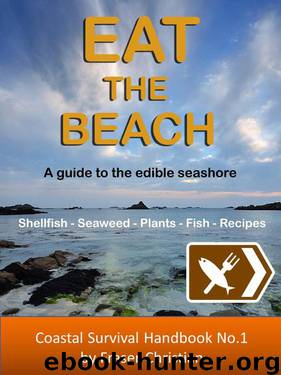Eat the Beach: A Guide to the Edible Seashore (Coastal Survival Handbooks) by Fraser Christian

Author:Fraser Christian [Christian, Fraser]
Language: eng
Format: epub
ISBN: 9781910056035
Amazon: 1910056030
Publisher: Practical Inspiration Publishing
Published: 2013-11-29T05:00:00+00:00
Where to look and how to collect
Any bucket or tub with a handle is a good vessel for carrying the forage in, along with a small net bag. Old onion sacks are ideal and can be used for both carrying and catching in flooded gullies and pools. As storms often pound exposed headlands and rocky shorelines, most of the larger specimens will have been washed off the rocks there. They can be found hiding in the deeper, sheltered gullies, sometimes lightly covered with sand or seaweed, especially the larger mussels. Use the end of your foraging stick to carefully poke around the pools and gullies to expose what hides within them.
Note: never use your finger for fear of cuts from sharp broken shells, or the nip of an angry crab!
Mussels and winkles can be prised from their footings with relative ease. Limpets need slightly more persuasion to retrieve, with a good swift strike needed from the stick or a suitable pebble. If you fail to remove them with the first blow leave them alone: the initial shock will cause them to hold fast and firm, making them almost impossible to remove in one piece, not only resulting in wasting valuable energy but also smashing them to smithereens. (Although if this happens, you can at least use them as bait for hooks or fish traps.)
It’s an old saying that shellfish should never be eaten during any month without a letter ‘R’ in its name. This takes its foundation from two sources, firstly that these summer months often see higher concentrations of algal blooms present. These can contain toxic bacteria, sometimes referred to by fishermen as ‘May rot’. Secondly, during hot weather the complex proteins of shellfish biodegrade quickly and therefore in times before refrigeration it would not have been possible to transport the shellfish safely over great distances. If you do want to transport your find home a cool bag and ice packs are ideal. Cover your shellfish in wet seaweed or a damp cloth.
Note: shellfish will die if submerged in water for long periods, or if allowed to dry out.
One of the best times to forage is on or around a new or full moon, during Spring tides. This is when the tide is at its highest and also its lowest, exposing more of the rocks, gullies and deep pools.
Note: Never collect or eat shellfish that are not obviously alive or firmly attached to the rocks. Mussels, like other bivalves including scallops and oysters, should always be firmly closed when alive and should open when cooked.
If the shellfish are to be boiled in a pan, the shells must first be scraped and scrubbed in the sand or gravel before cooking.
The convenient thing about shellfish when cooking in a bushcraft situation is that the shells act as individual cooking vessels. Mussels can be placed around the edge of the fire until they open and are cooked. Don’t put them on top of the fire as they hold within them seawater which may put out the fire as they open.
Download
This site does not store any files on its server. We only index and link to content provided by other sites. Please contact the content providers to delete copyright contents if any and email us, we'll remove relevant links or contents immediately.
Periodization Training for Sports by Tudor Bompa(7934)
Bodyweight Strength Training by Jay Cardiello(7681)
Therapeutic Modalities for Musculoskeletal Injuries, 4E by Craig R. Denegar & Ethan Saliba & Susan Saliba(7602)
Born to Run: by Christopher McDougall(6899)
Imperfect by Sanjay Manjrekar(5683)
Wiseguy by Nicholas Pileggi(5333)
Shoe Dog by Phil Knight(4902)
Paper Towns by Green John(4811)
The Body: A Guide for Occupants by Bill Bryson(4595)
The Rules Do Not Apply by Ariel Levy(4537)
Endurance: Shackleton's Incredible Voyage by Alfred Lansing(4518)
Bodyweight Strength Training Anatomy by Bret Contreras(4482)
Tuesdays with Morrie by Mitch Albom(4413)
Yoga Anatomy by Kaminoff Leslie(4108)
The Sports Rules Book by Human Kinetics(4084)
Science and Development of Muscle Hypertrophy by Brad Schoenfeld(3974)
Dynamic Alignment Through Imagery by Eric Franklin(3927)
Exercise Technique Manual for Resistance Training by National Strength & Conditioning Association(3790)
Bodyweight Strength Training: 12 Weeks to Build Muscle and Burn Fat by Jay Cardiello(3785)
